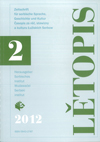Wuwiće mjezysłowneho sandhija w delnjoserbskich a přechodnych dialektach na pozadku sociolinguistiskich změnow
REVIEW: The Development of external sandhi in Lower Sorbian and transitional dialects against the background of sociolinguistic changes
Author(s): Lechosław JoczSubject(s): Language and Literature Studies
Published by: Domowina-Verlag GmbH / Ludowe nakładnistwo Domowina
Keywords: Lower Sorbian; sociolinguistic; dialect; voicing; sandhi; bilingualism; delnjoserbski; dialekt; fonetika; dwurěčnosć
Summary/Abstract: The aim of the paper has been to analyse later development of external sandhi in Lower Sorbian and transitional dialects against the background of sociolinguistic changes. The research was conducted on material from eight selected villages: Debsk, Dešno, Drjejce, Hochoza, Rowne, Trjebin, Turjej and Wjerbno. The results have shown that the picture has changed completely over the last century. The Serbski Rěčny Atlas (Sorbian Languge Atlas) as well as Michałk reveal an 85.9% preservation of etymological voicing in the aforementioned position; however, in more recent dialectal material this figure is reduced to a mere 10.6% of all relevant instances. Voiceless sandhi as it occurs in German has been observed in speakers born around the turn of the 20th century. This concerns the whole Lower Sorbian dialectal territory under observation. Clearly, there is a very close correlation between the speaker’s year of birth and the preservation of etymological voicing in sandhi before a sonorant (= -0.84). This change was very rapid (it took place within just two generations), which correlates with the development of total bilingualism in Lower Lusatia. The development of total bilingualism was a result of various political, educational and sociological changes during the 19th century.
- Issue Year: 2012
- Issue No: 2
- Page Range: 105-113
- Page Count: 9
- Language: Sorbian languages
- Content File-PDF

